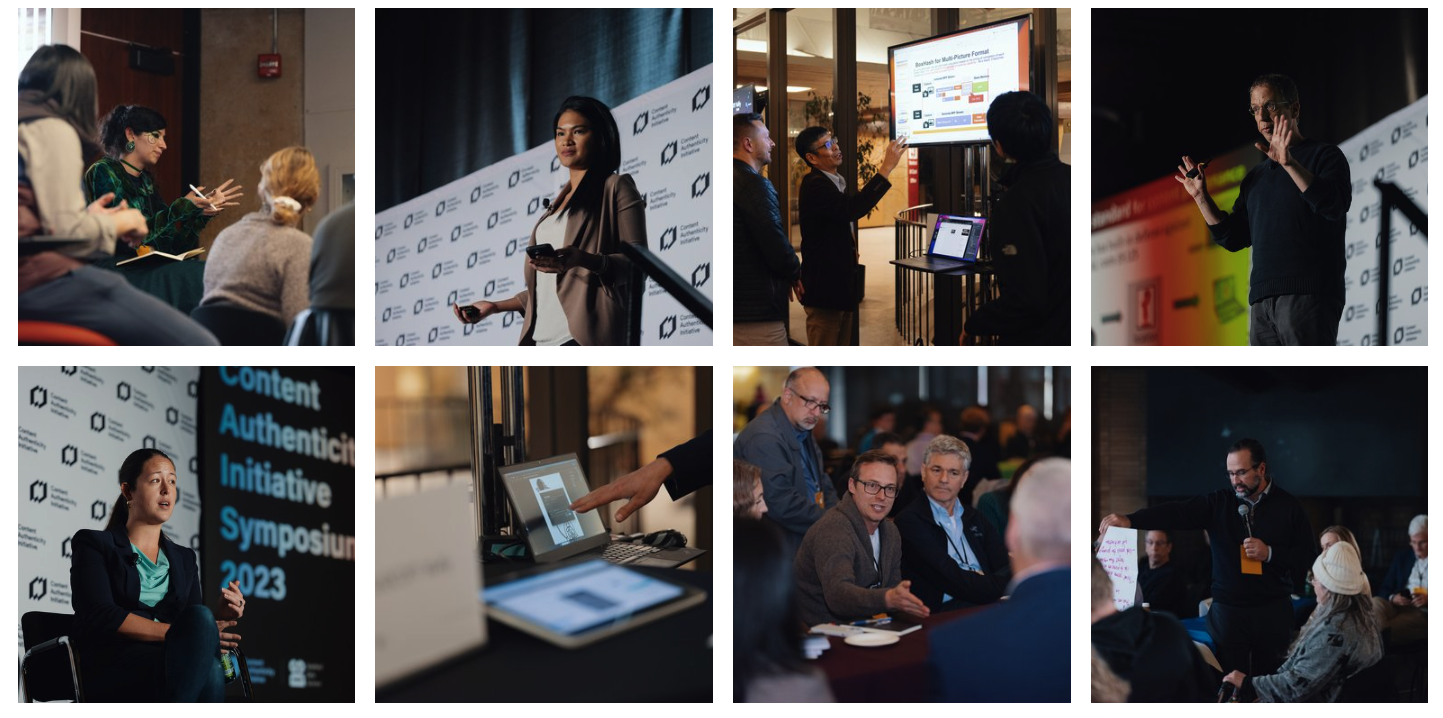CAI Symposium 2023: momentum for a trustworthy and transparent digital ecosystem

When a group of 59 organizations gathered in January 2020 for the first Content Authenticity Initiative (CAI) Summit, generative AI tools were not available for mass consumption. The main themes then were media literacy, context and intent, and the need to find a solution that drives trust and transparency online while mitigating the potential for bad actors.
Those discussions laid the foundation for the C2PA standard, verifiable Content Credentials, and the CAI’s open-source tools. Attendees envisioned these pillars as a way of ensuring clarity about the origins and history of the visual stories and media we consume online.
Back in 2020, the proliferation of mis- and disinformation across social media was also top of mind. Newsrooms and readers were struggling with challenging questions: How can we verify the origins of photographs and videos? How do we confirm facts emerging from a breaking news event? How do detection tools and digital forensics keep up with technological advances and the torrent of content before it goes viral?
Today, the speed of innovation in generative AI has again brought trust and transparency to the forefront. The potential of AI to both do good and cause harm is a dominant question in industry, policy, and media circles.
At this year’s CAI Symposium, held on Dec. 7, similar themes emerged. This time, over 200 people attended—from direct business competitors to experts in cryptography, identity, media, and policy. What they had in common was a commitment to the pursuit of an open solution to build trust and transparency into the digital ecosystem. Participants reflected the growing momentum of C2PA adoption across devices, software, services, and platforms.
Co-hosted with Stanford Data Science, the event was a full day of presentations, breakout sessions, and hands-on demonstrations from the CAI community.
Three takeaways from the CAI Symposium:
1. Scaling the chain of trust. Speakers from Adobe, the Partnership on AI, and WITNESS alluded to the importance of scaling trust and transparency solutions from the ground up, starting with frontier models, research, and development stages to the end-user experience. We saw hardware innovations in the form of Leica’s M11-P camera, the world’s first Content Credentials-enabled camera, which the company plans to extend to other products. With the introduction of generative AI tools on mobile devices, Qualcomm shared how building the C2PA standard into its chip processers can add transparency and mitigate potential harms.
2. Elections and media integrity. Forty countries representing 3.2 billion people will go to the polls in 2024, and we’re already seeing AI-generated images and videos influencing the democratic process. Additionally, a steady stream of misleading imagery and deepfakes are emerging from the wars in Ukraine and Gaza. The stakes have never been higher for media authenticity, and our work in this space is critically important. We were thrilled to highlight that BioBioChile became the world’s first media organization to implement Content Credentials on a live news website.
3. User experience and consumer education. Significant work lies ahead to establish the Content Credentials icon as the starting point for a new language of authenticity and context. Looking ahead to 2024 and beyond, one area with immense potential for innovation is ensuring an accessible, simple, and clear experience across mobile and web platforms. As technology continues to advance, it will be crucial to create a seamless and user-friendly interface for verifying content authenticity. This commitment to accessibility and clarity will play a pivotal role in enhancing user experience and promoting trust in the digital landscape.
The expertise and industry leadership that the CAI community brings spans engineering, product, trust infrastructure, policy, media, creativity, and education. We’re inspired by the ever-increasing adoption of Content Credentials and excited to take on the challenges ahead, together.
What began as a sea of promising ideas at the 2020 CAI Summit has evolved into a deep focus on deploying Content Credentials. The way forward depends on enabling honest discourse, surfacing challenges, and building solutions. If one thing was evident at this year’s Symposium, it's this community's commitment to that path.
Thank you to our speakers, moderators, and demo presenters!
- Opening Remarks by Dana Rao, Adobe
- Leica Content Credentials by Nico Kohler and Jesko von Oeynhausen, Leica
- C2PA Primer by Leonard Rosenthol, Adobe
- Trust and attestation in a modern mobile SoC by Asaf Shen, Qualcomm
- Navigating Trust: Provenance Technology in Journalism by Santiago Lyon, Adobe and David Clinch, Media Growth Partners
- Perspectives from the MediFor and SemaFor Programs by Matt Turek, DARPA
- Content Authenticity with Zero Knowledge by Dan Boneh, Stanford University
- Safe and Sound? Public Policy and AI by Rebecca Finlay, Partnership on AI
- Closing Remarks by Hany Farid, UC Berkeley
Watch the highlights and speaker recordings. Join the movement to restore trust and transparency online.
Photography by Adam Perez

Breakout Sessions and Moderators
- Identity and Authenticity with Eric Scouten, Adobe and Nathan Freitas, The Guardian Project
- User Experience for Media Authenticity with Pia Blumenthal and Andrew Kaback, Adobe
- Open source C2PA with Maurice Fisher, Gavin Peacock, Adobe
- Provenance in Digital Media, with Santiago Lyon, Adobe
- Addressing AI Image Abuse Beyond Provenance with Dr. Rebecca Portnoff, Thorn and Henry Ajder, Latent Space
- The C2PA Technical Specification, Present and Future with Leonard Rosenthol, Adobe/C2PA Technical Chair and Andrew Jenks, Microsoft/C2PA Chair
Demo Presenters
- DataTrails: Establishing a new model of digital trust by assuring provenance and integrity of data crossing business and application boundaries.
- Leica Camera AG: The M11-P, the world's first camera to guarantee the source of images through the Content Credentials standard.
- ProofMode: Capture, share, and preserve verifiable photos and videos for Android and iOS.
- Nikon: Content Credentials technology in exhibiting cameras, the industry-leading mirrorless Z 9, bringing provenance and authenticity to digital images at the point of capture.
- Reuters: Preserving trust in photojournalism through authentication technology.
- SmartFrame: Building trusted collections with New Zealand Rugby and Manchester City F.C., using Content Credentials and image-streaming technology to serve and protect images.
- Truepic, Pixelstream, BioBioChile: The first end-to-end Content Credentials workflow for news, implemented by BioBioChile with Truepic’s Mobile Capture and Pixelstream’s CDN and image-editor platform.
- Yuify by Wacom: Prove authorship with secure records and receive a hassle-free licensing tool.


